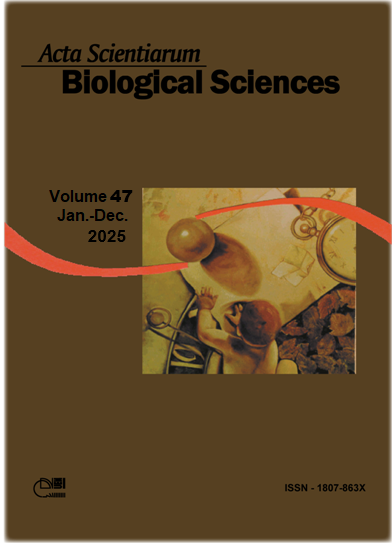In vitro binding capacity of free bilirubin by aqueous extract of Marrubium vulgare L.
Resumo
Marrubium vulgare L. (MVL.) has been traditionally used to treat kernicterus. However, the anti-jaundice effects and mechanisms of MVS. on free bilirubin remain poorly understood. The present study assesses the anti-jaundice effect of the aqueous extract of MVL, by measuring the percentage of adsorption (binding) of this extract on plasmatic free bilirubin obtained from kernicterus newborns (n = 40). The plant’s aerian party and leaf pouder histological and phytochemical properties of MVL were examined. Our results show that dry aqueous extract of MVL contains total phenols (51.5 ± 0.40 mg EAG g-1), condensed tannins (14.7 ± 0.49 mg ECAT g-1) and flavonoids (25.33 ± 0.41 mg ECAT g-1). Histological examination showed that both the surfaces of leave and stems are covered by a protective hair; glandular and non-glandular trichomes which produced various secondary metabolites. Free bilirubin was significantly bound by the aqueous extract of MVL at different concentrations (250-1250 µg ml-1) to the extent of (33.6 - 54.61%). In the light of these preliminary findings and future experimental studies, it indicates that this plant may be used as a source of therapeutic agent for kernicterus and can be an alternative treatment to the currently available treatments such as phototherapy and exsanguino-transfusion, which have serious short and long term complications.
Downloads
Referências
Ahmed, B., Masoodi, M. H., & Khan, S. (2009). Anti-hepatotoxic activity of Marrubium vulgare L. in carbon tetrachloride induced toxicity. Journal of Pharmaceutical Research, 8(1), 35-38. https://doi.org/10.18579/jpcrkc/2009/8/1/79785
Akrout, A., Gonzalez, L. A., El Jani, H., & Madrid, P. C. (2011). Antioxidant and antitumor activities of Artemisia campestris and Thymelaea hirsuta from southern Tunisia. Journal of Food and Chemical Toxicology, 49(2011), 342–347. http://doi:10.1016/j.fct.2010.11.003
Barry, T. N., & Manley, T. R. (1986). Interrelationships between the concentrations of total condensed tannins, free condensed tannins and lignin in Lotus sp. and their possible consequences in ruminant nutrition. Journal of Science of Food and Agriculture, 37(3), 248-254. https://doi.org/10.1002/jsfa.2740370309
Boubakeur, H., Rebbas, K., & Belhattab, R. (2017). Activité antioxydante et antibactérienne des extraits d’Helichrysum stoechas(L.) Moench. Phytothérapie, 1-11. https://doi.org/10.1007/s10298-017-1104-5
Bouzabata, A. (2015). Microscopic analysis of Curcuma longa L. using multivariate test. International Journal of Pharmacognosy, 2(4), 173-177. https://doi.org/10.13040/IJPSR.0975-8232.IJP.2(4).173-77.
Council for International Organizations of Medical Sciences [CIOMS]. (2016). International Ethical Guidelines for Health-related Research Involving Humans (4th ed.).
Djahra, A. B., Bordjiba, O., Benkherara, S., & Benkaddour, M. (2015). Evaluation of Algerian spontaneous species:phytochemical and biological study of aromatic and medicinal plant Marrubium vulgare. Phyto Chemistry & Bio Substances Journal 9(1), 2-9. https://doi.org/10.163.pcbsj/2015.9.1.2
El Bardai, S., Lyoussi, B., Wibo, M., & Morel, N. (2001). Pharmacological evidence of hypotensive activity of Marrubium vulgare L. and Foeniculum vulgare in spontaneously hypertensive rat. Clinical and Experimental Hypertension, 23(4), 329-343. https://doi.org/10.1081/ceh-100102671
Herrera-Arellano, A., Aguiar-Santamaría, L., García-Hernandéz, B., Nicasio-Torres, P., & Tortoriello, J. (2004). Clinical trial of Cecropia obtusifolia and Marrubium vulgare leaf extracts on blood glucosa and serum lipids in type 2 diabetics. Phytomedicine, 11(7), 561-566. https://doi.org/10.1016/j.phymed.2004.01.006
Hu, Y.-B., Wang, Z., & Xu, S.-Y. (2008). Treatment of corn dietary fiber with xylanase increases its ability to bind salt, in vitro. Food Chemistry, 106(1), 113-121. https://doi.org/10.1016/j.foodchem.2007.05.054
Kahlouche-Riachi, F., Djerrou, Z., Ghoribi, L., Djaalab, I., Mansour-Djaalab, H., Bensari, C., & Hamdi-Pacha, Y. (2015). Chemical characterization and antibacterial activity of phases obtained from extracts of Artemisia herba alba, Marrubium vulgare and Pinus pinaster. International Journal of Pharmacognosy and Phytochemical Research, 7(2), 270- 274.
Mitra, S., & Rennie, J. (2017). Neonatal jaundice: etiology, diagnosis and treatment. British Journal of Hospital Medecine, 78(12), 699-704. https://doi.org/10.12968/hmed.2017.78.12.699
Mittal, V., & Nanda, A. (2016). The pharmacognostical evaluation of the Marrubium vulgare Linn Collected from the Pulwama district of Jammu and Kashmir state in India. Journal of Chemical and Pharmaceutical Research, 8(10), 7-15.
Pavela, R. (2004). Insecticidal activity of certain medicinal plants. Fitoterapia, 75(7-8), 745-749. https://doi.org/10.1016/j.fitote.2004.08.005
Popoola, O. K., Elbagory, A. M., Ameer, F., & Hussein, A. A. (2013). Marrubiin. Molecules, 18(8), 9049-9060. https://doi.org/10.3390/molecules18089049
Stulzer, H. K., Tagliari, M. P., Zampirolo, J. A., Cechinel-Filho, V., & Schlemper, V. (2006). Antioedematogenic effect of marrubiin obtained from Marrubium vulgare. Journal of Ethnopharmacology, 108(3), 379-384. https://doi.org/10.1016/j.jep.2006.05.023
VanderJagt, T. J., Ghattas, R., VanderJagt, D. J., Crossey, M., & Glew, R. H. (2002). Comparison of the total antioxidant content of 30 widely used medicinal plants of New Mexico. Life Sciences, 70(9), 1035-1040. https://doi.org/10.1016/s0024-3205(01)01481-3
Wamatu, J. N. A., Hoffmann, E., Muetzel, S., & Becker, K. (2006). An alternative test protein for the determination of protein precipitation capacity of tannins. Proceedings of the British Society of Animal Science, 2006, 172. https://doi.org/10.1016/0003-2697(87)90596-3
Woodward A., & Reed, J. D. (1989). Influence des substances polyphénoliques sur la valeur nutritive des fourrages ligneux: synthèse des recherches menées par le CIPEA (CIPEA Bulletin, 35, 2-13). https://hdl.handle.net/10568/10847
DECLARAÇÃO DE ORIGINALIDADE E DIREITOS AUTORAIS
Declaro que o presente artigo é original, não tendo sido submetido à publicação em qualquer outro periódico nacional ou internacional, quer seja em parte ou em sua totalidade.
Os direitos autorais pertencem exclusivamente aos autores. Os direitos de licenciamento utilizados pelo periódico é a licença Creative Commons Attribution 4.0 (CC BY 4.0): são permitidos o compartilhamento (cópia e distribuição do material em qualqer meio ou formato) e adaptação (remix, transformação e criação de material a partir do conteúdo assim licenciado para quaisquer fins, inclusive comerciais.
Recomenda-se a leitura desse link para maiores informações sobre o tema: fornecimento de créditos e referências de forma correta, entre outros detalhes cruciais para uso adequado do material licenciado.












1.png)




3.png)













